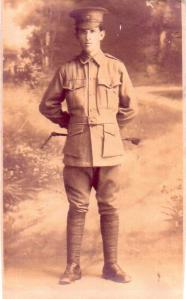No 1- Arthur John Montgomery Bleakley
Arthur John Montgomery (Monty) Bleakley was born on the 24/4/ 1892 at home in Delaney’s Ck and lived his life on the land with his family. He was a horseman, an excellent shot and although a rebel everybody loved him. He joined up on the 29/7/1915 aged 23 years and three months. After training in the Gatton Training centre, he embarked at Brisbane for Egypt aboard the H.A.A.T. ship’ Serang Bee’ on the 21/10/1915.
He was a rebel but typical of the Australian soldier. The rural young men of Australia were much sought after, their reputation quickly grew as they were known for their courage , determination and their expertise with using a rifle. because of that they were used as ‘cannon fodder’ and always sent in first, to take the sting out of the enemy and in doing so, many perished whilst getting the job done. In many places in Europe, from this war and the next theatre of war ‘1939-1945’, Australians are still revered.
Monty loved to party and with his friends, in their free time. would spend much time at the D.Aguliar pub . He was also a favourite with the ladies and had many friends but no close relationship before he left for the war zone.

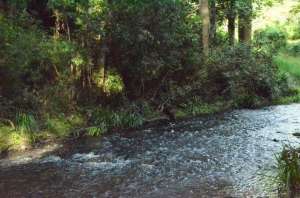

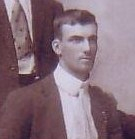


On the ship going over he tried his boxing skills but only one chap, a butcher, was a match for him.
So, Monty followed where many had gone before and in the short time he had been in the army, made quite a name for himself by being drunk, missing from his billet and talking in the ranks. Not major crimes but still earned him many hours in detention perhaps he resented the restrictions because of the wealthy family he came from, not being used to being kept on a short leash or maybe it helped nullify the horror they were living and fighting every day and anyway, who could be completely trained after just three months but perhaps they were regarded as temporary soldiers with an uncertain future, so just given the basics.
He arrived on the 1st March 1916 in Egypt and proceeded to Zeitou where he earned his first detention (168 hours). he went on to join the 12 Btn. and on the 11th March,his battalion took the town of Serapeum. On the 29th March 1916 he proceeded to join the BEF in Alexandria and boarded the “Corsican’ bound for Marseilles France on the 6th May 1916.
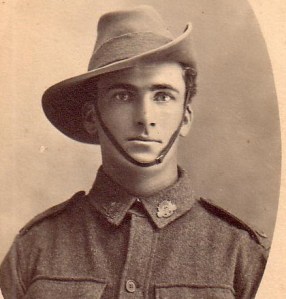


He received another detention before he was wounded in action at Pozieres and died of his wounds on the same day, in the Australian Field ambulance ” In the Field”. One of his shoulders had blown off and realizing he had little chance of living, allowed his wounded comrades to be moved ahead of him to the hospital giving himself no chance of survival, therefore showing what an unselfish and courageous young man he was. How terrible it must have been for him, knowing he was dying and no loving hand to hold so far from the hills of home. He was buried in Warloy-Baillion Military Cemetery, five miles west of Albert, by the Rev. C.H. Sheppard. ‘Monty was as game a soldier as ever left Australia’ so wrote a comrade and chum in France

Written on the family grave in Toowong cemetery, Brisbane ‘also our second son A.J.M. (Monty) Bleakley 26 Batt. in France died in the Ist Field Ambulance, 24th July 1916 of wounds received in action at Pozieres. Buried in Military Cemetery, France aged 24 years.’
His nephew, Peter Belloc went to France to find his grave and on doing that, could not control his tears. After some time an elderly man who had been watching him, went over and said ‘That is the reaction of everyone, male or female, who come here.
The beautiful Somme valley, is part of the Picardie region of France, the word Somme is a Celtic word meaning tranquillity. It is hard to imagine that in this beautiful place, horrendous battles were fought and many died, including thousands of Australians, losing their lives for a cause they barely understood but which the people of northern France, have never forgotten, nor will they ever forget. The Western Front has not had the recognition that Gallipoli has but two battles in 1916 at Fromelles and Pozieres -28,000 Australians died which is about the same number that fell after eight months of conflict on the Turkish peninsula. In total, 295,000 Australians served on the Western Front, between 1916-1918, 48,000 of whom died and 156,000 were wounded. It is hard for us to appreciate the magnitude of courage, gallantry and sacrifice, let alone the enormous great loss that has occurred here on the battle fronts. There is a ridge around Pozieres more sewn with Australian sacrifice than any other place on earth.


France is a country of breathtaking beauty but there is something about the hills of the Somme, that reverberate more than most for an Australian because there, in at least one town you will find streets with names such as Rue de Melbourne and Rue de Adelaide with windows displaying kangaroos and koalas clutching their Australian flags but perhaps, it’s because the spirits of nearly a generation of Australians, some of our finest and best live there, forever pining for the land of their forebears and home. It was in this part of France on April 24th and 25th 1918 that Australian soldiers gained legendary status by stopping the German offensive and in doing so turned the tide of the war. Previously the German Army, in less than one week, had managed to regain all the territory that had been previously been won by the British and the Australians in the previous 18 months (Australia’s official historian Charles Bean)
To mention just two operations, two Australian soldiers were able to reach the outskirts of Villers-Bretonneux and take an entire platoon of enemy troops with nothing more than a broken Lewis gun. The other, one man with a light machine gun, took an enemy outpost, killing seven soldiers and capturing two others, prompting the French Prime Minister Georges Clemenceau to declare ‘We knew you would fight a good fight but we did not know from the beginning, you would astonish the whole continent with your valour’. This cry was heard after more than one battle ‘Vivent les Australians. Vous les tendres’. Stay alive Australians. You will stop them’.
It makes you wonder why we do not commemorate on Anzac Day the tide turning triumphs of Villers-Bretonnex where our soldiers were saviours of the French, instead of the heroic but unfortunate campaign at Gallipoli where our soldiers were cannon fodder for the British and a lost cause. The British landed them in the wrong place where many were slaughtered by the Turks on the cliffs,before they reached the beach but had they landed further along the coast it could well have been a different story.
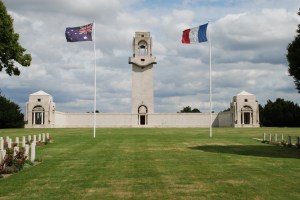

We will never know the conditions that they endured, we can only imagine the deprivation, despair and longing for family that lived with them daily, as well as the horror of orders to go out and kill or be killed so we can only, more than 100 years on, remember and honour them.
Written on the Australian War Memorial in Northern France.
“On this monument” said King George V1 in 1938, barely a year before the outbreak of World War 11 “is an inscription telling us and others who visit this hill in the years to come, that it perpetuates the memory of the Australian Imperial Forces in France and Flanders, and the 11,000 of them who fell in France and have no known grave”.
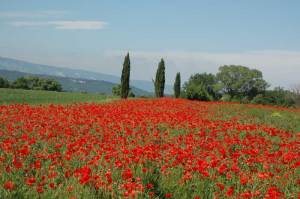
o 2- Albert Claude Pugh Bleakley (Claude)’
Claude, eldest son of Arthur and Emma Bleakley (Findlay) of ‘Eversleigh” Harlin in the Brisbane valley born on the 15/3/1896 in Esk Qld. Claude joined the AIF on 11/1/1916 and after receiving basic training embarked from Sydney on the ‘Hawkes Bay’ on 20/4/1916 and sailed to France for active duty.

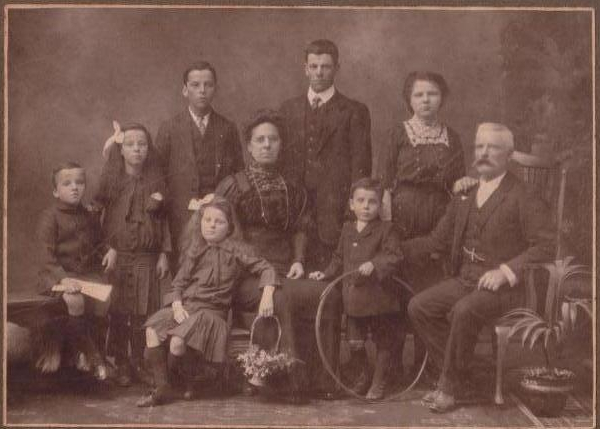

He was reassigned to the 17th Reinforcements for the 12 Battalion AIF. Claude saw active service at the Somme, Pozieres and Ypres before returning to the Somme in the latter part of 1916 so missing his cousin Monty who died in July. In 1917, the Battalion was dispatched to Belgium and were involved in the pursuit of Germans to the Hindenburg Line.
In May, the 12th Battalion, as part of the first division. relieved the Second Division in the second battle of Bullecourt where Claude was wounded. The actual date is difficult to determine as the battle was fought between the 3rd and 9th May 1917.The day he was reported wounded was the 10th May but by then the battle had finished.


A German shell land on the trench in the Australian Line where he was stationed, wounding and burying him in the rubble. He was rescued and repatriated to a hospital in England on the ship HS “Aberdonian” where he convalesced before returning to Australia on the 25/8/1917. His wounds were of such a nature as to cause him to be discharged from military service on the 28/11/1917.
After his discharge he returned to “Eversleigh”, however his health further deteriorated and he was transferred to an army repatriation hospital in Stanthorpe Queensland where he passed away on the 19/4/1919. from the wounds he received at Bullecourt. For services to King and Country he received the following medals-1914/15 star, British war medal, Victory medal
The 12th Battalion was among one of the first infantry units raised for the AIF during WW1and received significant Battle honours including-Landing at Anzac, Sulva Gallipoli 1915, Egypt 1915-16, Somme 1916-18. Pozieres, Bullecourt, Ypres 1917, Menin Road, Broodeseinde, Polygon Wood, Poelcappelle, Passchendaele, Lye, Hazelbrook, Amiens, Albert 1918, Hindenburg Line, Eperty, France and Flanders Excerpt from a book compiled by the Kilcoy District Historical Society.

Although Bullecourt is a remembrance site, it is also a pleasant village for a walk. In the midst of the Artois countryside. Starting at the village square, the’Sentier des Autraliens’ is a walking trail that introduces you to its charms, with the battlefield as the common thread


William James Robinson
William James Robinson (1895-1914) in Malta eldest son of Frederick and Kate Robinson- (Fred was in the East Surreys Regiment stationed in Malta when he married Kate and William was born)- killed in action 24/8/1914 while holding the line at the canal near Mons France


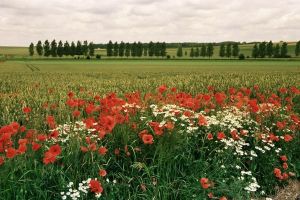
They were originally buried where they fell in isolated graves in the Communes and Herbieres.During the war the bodies of these soldiers were exhumed and reburied by the Germans in certain graves in Hautrage Military Cemetery but, unfortunately, it proved impossible to identify the graves individually. “In the circumstances it had been decided to mark each of the graves with a Special Cross to bear the name, regimental particulars and date of death of one of the soldiers and an inscription reading ‘Buried near this spot’. ” The number of the grave which was marked with the name of Private W.J. Robinson is 131

William enlisted as a boy soldier and there are no known details but his niece Moira Jones has two letters sent to her mother Ellen Maude (his sister)from Ireland shortly before the 1914-18 war and he told her he was expecting to be posted any day and he would be glad to leave Ireland. He also said he longed to be home for the summer to be with them all. That was not to be as he was dead before the summer was over and died in the first week of the war. There were others like him anxiously wanting to go to war but they were boys. They went anyway and their lives were over before they had begun.

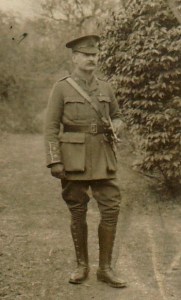




The family home was in Kingston-On -Thames close to the East Surrey’s Regimental Headquarters
-Donald Albert Fraser
Donald Fraser, 1st son and third child of Alexander and Jane Fraser of “Hillside’ Bonshaw Q. property, born 13/11/1893 grew up on the family property, enlisted 10/1/1916 . Private D.A. Fraser, no 1646 “B” Co . Machine Gun Section, 56th Battalion-sailed on the 13/5/1916, killed in action on the Somme 3/2/1917








Don went off with Will Prior ( he lived on a neighbouring property) and others from Lagoon Flat and Will was with Don when, during the Battle of the Somme, he was killed. Will returned home and later married Elizabeth Fraser. They called their home in Auburn Sydney “Bullecourt” after the place in France where heavy fighting took place and for mate ship. Don is buried in the A.I.F. Burial Ground Flers France.
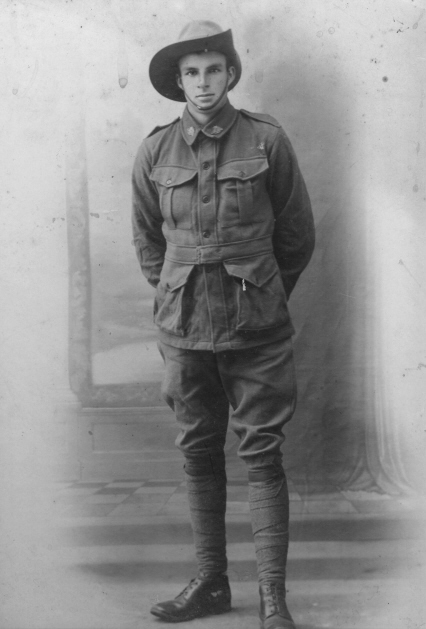
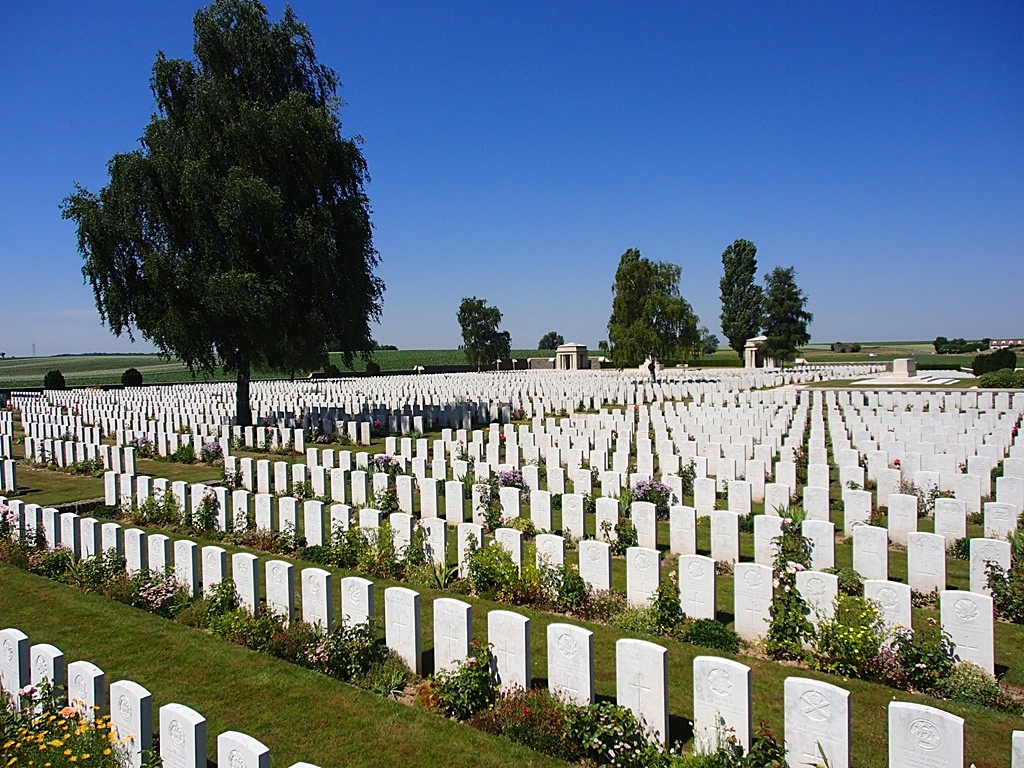

AIF Burial Ground is two kilometers north of the village of Flers, in the Department of the Somme. The cemetery was begun by Australian medical units, posted in the neighbouring caves, in November 1916-February 1917. These original graves are in Plot 1, Rows A and B. It was very greatly enlarged after the Armistice when almost 4000 Commonwealth and French graves were brought in from the battlefields. The great majority from the autumn of 1916, but 1 is from 1914 and others from the spring of 1917 and the spring and summer of 1918.
Donald Albert Fraser , born 3/11/1893 Lagoon Flats, died 3/2/1917 Somme France age 23 . Buried AIF Burial Ground, Grass Lane, Flers France, Somme -Plot 111 Row B, Grave 12. Service no 1646-Enlisted 10/1/1916 Rank Private.
Unit 36 Battalion 1st reinforcements, 56'Battalion, B Company, Machine Gunner.
Embarked 13/5/1916 from Sydney, on board HMAT A72 'Beltana'
Medals British War Medal on 22/4/1922, Victory Medal 11/4/1923, 1914/15 Star
Remembered on Roll of Honour Panel No 162
From his Roll of Honour Circular, Town in Australia he was chiefly connected with (which his name ought to come on the Memorial: Texas Queensland.
Next of Kin WW1: Mrs Jane Fraser Lagoon Flat Queensland.
Family military connections : Brother Alexander Claude Fraser died Victoria Barracks Sydney 11/7/1915
Oath taken 10/1/1916 by Attesting Officer F H Jery
Description of Donald Albert Fraser on Enrollment
Height 5 feet 11 inches
Weight 160 pounds
Chest Measurements 33-36 inches
Complexion Dark
Eyes Dark brown
Hair Dark brown
Medical Examination at Inverell 15/1/1916.
Information from the Australian Red Cross Society on Wounded and Missing in WW1 given by eye witness Sgt. J C Bisson 2788 56th Battalion -3rd Hospital Dartford, Kent England- ' I saw him dead at Le Transloy. He had been caught by a shell and very badly blown about. I buried him near the place of casualty and marked his grave with a cross bearing all his particulars. I knew him well, he was a Machine Gunner at time of casualty
Taken by W. Orman at London 8th October 1917
5 Alexander Claude Fraser
Claude 4th child and second son of Alexander and Jane Fraser was born on the 8/10/1895 Lagoon Flat , died 11/7/1915, Garrison Hospital, Victoria Barracks, Paddington Sydney NSW
Cause of death : Lobar Pneumonia and Meningitis
Buried Rockwood Necropolis, Presbyterian Section 5B 7694
Service No – Enlisted 22/6/1915 Rank private
Unit 8th Reinforcement, 1st Battalion
Next of kin-Mrs Jane Fraser, Lagoon Flat Qld
Family military connection-Brother Donald Albert Fraser K.I.A. 3/2/1917, Somme France
Oath taken 23/1/1915, Liverpool NSW
Description of Alexander Claude Fraser on Enlistment
Height 5 feet 101/2 inches
Chest Measurement 33-35 inches
Complexion Fair
Eyes Blue
Hair Fair
Medical Examination at Inverell 15/1/1915
Written on a plaque Texas Sub-Branch RSL Wall
R.S.S.A.I.L,A
1914-1918
Lest We Forget
Fraser C.A.
Fraser D.A.
WW1 ‘ Their Name Live Forever More’
There was talk at the time that a German sympathizer doctor had injected and killed many soldiers with meningitis and Claude was one of them. This was later confirmed.
Private Claude Alexander Fraser
Birth Place Australia: Queensland, Texas
Death Date 11 July 1915
Death Place Australia: New South Wales, Sydney, Liverpool
Final Rank Private
Service Australian Imperial Force
Units Australian Imperial Force 1st Australian Infantry Battalion
Places Liverpool Texas
Conflict/Operation First World War, 1914-1918
No 6 Ernest Herbert Bleakley
Ernest was 21 years and 7 months when he joined up on the 28/7/1915. He never saw action as he died from meningitis and heart failure on the 2/9/1915 in the Enoggera Army Camp and is buried in the family plot in the Toowong Cemetery Brisbane. Written on the grave- Pte Ernest Herbert Bleakley 25 th Batt., son of William and Bertha Bleakley, died 2/9/1915 aged 21 years.
Ernest Herbert Bleakley
There were strong rumours circulating at the time, that German sympathiser doctors were responsible for injecting the young men with meningitis. Indeed there were a great many men dying of the disease. This was later confirmed.
Ernest, after going with the first rush of adrenaline of joining up for King and Country had no clear idea just what he was letting himself in for, but in his case he never knew the horror that the boys had to live through, as his brother Monty who died far from home knew and his cousin Claude who received grave injuries,going through terrible pain and incapable of living a normal life, but died in own country buried among his people, albeit his uncle and his family.
Other than his war record , no one seems to know anything about this young man, he obviously was quieter than his brother Monty and was not involved in any wild behaviour or someone would have remembered.
roll-location
Roll of Honour Ernest Herbert Bleakley
Rank Private
Service Australian Imperial Force
Conflict/Operation First World War, 1914-1918
Conflict Eligibility Date First World War, 1914-1921
Date of Death 02 September 1915
Place of Death Australia
Place of Association Woodford, Queensland, Australia
Cemetery or Memorial Details Toowong Cemetery, Toowong, Brisbane, Queensland, Australia
Source AWM145 Roll of Honour cards, 1914-1918 War, Army
Location on the Roll of Honour
Ernest Herbert Bleakley’s name is located at panel 103 in the Commemorative Area at the Australian War Memorial (as indicated by the poppy on the plan).
Roll of Honour name projection
Ernest Herbert Bleakley’s name will be projected onto the exterior of the Hall of Memory on:
Tue 28 April 2020 at 9:21pm
Sat 20 June 2020 at 7:07pm
Sun 27 September 2020 at 2:37am
(L)Ernest (Middle top)Monty Bleakly (R) Cecil Franz and (middle bottom) Alfred McClure
Enoggera Military Camp W
No 7 Arthur Edward Franz
Arthur was born 19/1/1892 the son of William and Margaret Franz ‘nee Bleakley, He was a dairy farmer who went to war in February 1916.Regimental no 57. He was injured in August 1918 and admitted to Edmonton Military Hospital 12/8/1918 suffering a mild gunshot wound to his right thigh. Returned to Australia 10/5/1919.
Arthur disappeared from Moorina 6/4/1930. He went to bed in his room under the house, in good spirits, with his mother brother and sister upstairs but was not there in the morning and it was assumed that he had gone for his cows but he never came back, another mystery-his dog was still there. At 11 am Clem called his brother Theo. Theo was reported as saying ‘ Arthur had been gassed and wounded in the war and since returning in 1919 was occasionally depressed.He attributed this to war injuries as neither Arthur’s financial or domestic position caused him any worry and he was extremely temperate. A search by 40 neighbours and police found no trace of him. I have since been told that he had gone to a neighbour’s house to play cards and had an argument with a visitor, who was known to him and they had never got along and this night it escalated out of control, Arthur was killed by him and his body disposed of by said person – his body was never found. Obviously the family knew it but could not prove anything and they remained quiet about it for many years.



Bleakley
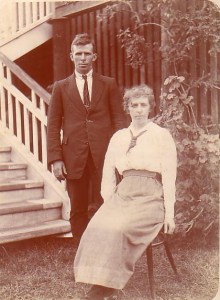

in the Upper Caboolture cemetery-. Very dangerous work and he is barefooted as well.

No 8 Cecil Charles Andrew Franz
Cecil Charles Andrew was born on the 4/11/1893 son of William and Margaret Franz. After Arthur went to war Cecil looked after the dairy but on receiving a ‘white feather’ episode, decided to join up on the 3/11/1916
He joined 42 Batt. 7th Reinforcement Regimental No 3031-embarked from Sydney on board HMAT A13 Wiltshire 7/2/1917 serving in Bonnay (Somme) France.
He died on the 26/5/1918 – admitted to King Georges London suffering a gunshot wound in the spine and died soon afterwards.
He was buried in Brookwood Military Cemetery, Surrey London.

Roll on Honour Australian War Memorial No 135.
